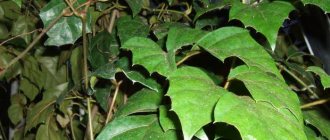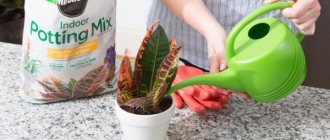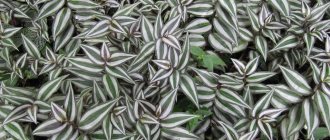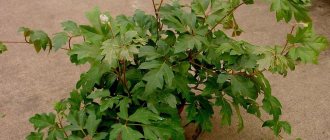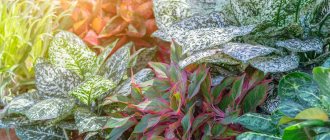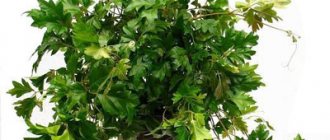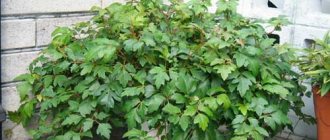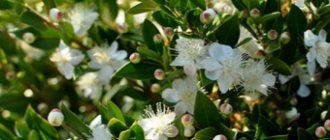The favorite flower of many gardeners is the birch houseplant. Its other name is rhombic rhombicus. This domestic vine is interesting because its leaves are very similar to the leaves of a real birch.
Because of this, they began to call her birch tree. From the article you will learn what kind of plant this is, what it is called correctly, what types of this plant are grown at home, and how to care for it.
Roicissus is very popular. It can be found in a variety of places: hospitals, offices, shops and even kindergartens. Many people keep it at home as it doesn't require much care and its rich greenery makes a great addition to home decor. People call it homemade grapes and bereka.
Houseplant birch: description
Birch, or rhoicissus, is closely related to the cissus family, which includes more than 300 species of shrubs, vines and subshrubs. This name comes from the Greek kissos, which means ivy. Roicissus, like cissus, is not an ivy; this name was given due to their external similarity. This plant is native to tropical forests.
The content of the article
- Houseplant birch: description
- Caring for a plant at home
- Reproduction of Rocius
- What diseases can indoor birch have?
- Folk signs about health benefits and harms
- How to make a phytowall from a birch tree
What does roisissus look like? This plant looks like a vine, see photo, the stems of which can grow up to two meters, the leaves are green all year round. In apartment conditions, cissus rarely blooms, but its flowers can hardly be called beautiful, since they are rather inconspicuous. But the birch leaves grow gorgeous - diamond-shaped, a little like the leaves of a real forest birch. This “living” climbing decoration comes from the grape family, and it is very easy to grow it yourself.
How many types of birch are there?
Rhombic rhoicissus - is a long stem (up to 1.5-2 m) with thin shoots and bright green leaves. The outer side of the leaves can be emerald, the underside - lighter tones. All stems, like the leaves, have a small “edge” of a reddish color. In addition, small tendrils can be found on the stems. Roissus of this species is suitable for growing in special flowerpots; it is used to decorate columns or phytowalls.
Cape roisissus is a climbing plant that can be grown on supports. Its stems reach a length of 2 meters. Characterized by rapid growth. It has beautiful decorative leaves that look like grapes. Most often used for volumetric phytocompositions.
Palmate roisissus is very different from its counterparts. It was named so because of the shape of its leaves, which look like fingers. This type is actively used for decorating rooms and phytofigurines. The leaves are painted in a bright emerald color, covered on the inside with fine reddish hair.
Felt roisissus has the simplest leaf shape of all, that is, round. The edge of the leaf is wavy, the leaves themselves are dark green in color. The outer side of the leaf is glossy and shiny, the underside has a small edge of reddish pile. When flowering, inflorescences of small cream flowers appear.
The three-toothed rhoicissus has a complex leaf structure; the plate is divided into 3 parts. The leaf edge is coarsely toothed. The upper side is painted dark green, the lower part of the leaf is in lighter colors. The flowers are yellow, with a barely noticeable green tint.
Useful video
By watching the video below you can learn about the features of caring for the Roicissus plant at home:
If you find an error, please select a piece of text and press Ctrl+Enter.
Cissus - kissos (Greek), means "ivy" , another name for "indoor grape" , is a vine of tropical origin. In nature, it is found in many tropical and subtropical jungles of both hemispheres.
its popular nickname “birch” because of its leaves, which are very similar to birch leaves. With proper care, it produces small flowers, which then turn into small berries . It clings to supports using antennae.
At home, indoor birch trees are grown in hanging pots, and then the birch shoots fall in the form of a green cascade, or are directed upward with the help of supports. You can make a wonderful combined composition when one part of the branches hangs freely downwards, and the other is directed upwards.
There is a long-standing belief that indoor birch gives a person strength, improves health, and prevents infections from colds. Absolutely unpretentious, quite simple in appearance, this plant can provide a huge amount of green mass, turning a room into a real greenhouse.
Caring for a plant at home
Homemade grapes or birch trees have long been living in the houses and apartments of lovers of ornamental plants. The plant is characterized by fast growth, unpretentiousness and the ability to create excellent living decor.
A few tips for caring for birch trees
This plant does not like exposure to direct sunlight. They can burn the leaves. If a birch tree is disturbed by bright light, this can be seen in its condition: the leaves will lighten several tones, they will lose their glossy shine, and they will begin to fade. In this case, you need to move the container with the flower to a more shaded place.
- A birch tree will grow better if its soil is loosened frequently. This should be done at least once a week.
- The flower does not like excess moisture, but despite this, the leaves need to be sprayed sometimes. Especially in winter, when greenery can suffer from dry air.
- There should be no drafts in the room where the birch tree lives. It is also not recommended to ventilate it on the balcony. The plant may get sick after such walks.
- To rejuvenate the vine, once a month you should carefully trim all old shoots and trim any that are too long. Then the flower will have a well-groomed appearance.
How to choose soil and replant
Before purchasing a birch tree in a store, you need to carefully inspect it. The leaves of the plant should not look drooping, in addition, the cuttings should have two buds.
The plant must be replanted every 3-4 years. You can make the soil yourself: to do this, you need to take 2 parts of soil from the garden, 2 parts with turf, 1 part of humus and add 1 part of coarse river sand. The resulting mixture will perfectly allow moisture to pass through and nourish the roots of the plant. If it is not possible to prepare the soil yourself, you can purchase it in special stores.
Roicissus can be transplanted into a flowerpot, hanging basket or shallow tub. If the owners have chosen a pot for him, then it should be small. This plant will not be comfortable living in a large space. The container must be made of natural material. There must be holes at the bottom for moisture drainage.
A layer of pebbles or expanded clay should be placed at the bottom of the pot. When the drainage is ready, you need to pour 3-4 cm of soil on top. Before planting a birch tree, you must carefully examine its roots and carefully remove all broken and dried ones.
Then the flower should be placed in the middle of the pot and sprinkled with soil. There is no need to compact it too much; you can only lightly press the soil with your fingers. There should be no empty spaces left near the roots. The roots of the birch tree should not be deeper than 5 cm. After the transplant is completed, the plant needs to be watered with settled water at room temperature.
The first days after transplantation, it is better to protect the flower from sunlight. It is best to hide it in a dark closet. If it takes root well, then it can be moved to a permanent place of residence. For the first 2-3 months, the flower does not need to be fed; it will take everything it needs from the soil.
How to choose lighting
Birch trees can tolerate both sun and shade well. But he still loves the shadow more. Direct sunlight can damage the delicate leaves of this plant, so it is better to keep it on a windowsill in the northern part of the apartment.
Owners should not forget that the vine is a tropical and delicate plant, and it does not tolerate life on a loggia or balcony. In the summer, it should also be in the apartment. Birch does not tolerate drafts and open spaces.
In summer, the air temperature should reach 20-25 degrees. This is the most favorable climate for homemade grapes. In winter, the temperature should be at least 16 degrees. When ventilating the room, do not allow cold air to enter the plant.
How to water a birch tree correctly
The plant, although tropical, is quite unpretentious. It can survive unfavorable conditions, but it is unlikely to survive a lack of water. When watering, you must follow one important rule: the plant does not like excess moisture, but there should not be dry soil in the pot either.
On average, 2-3 waterings per week are obtained. It depends on where exactly the pot with the vine is located. If closer to the ceiling, then the air there is hottest and driest, and the flower needs to be watered more often. If the roisissus lives on an ordinary windowsill, then 1-2 waterings will be enough for it. Several times a week you need to spray the leaves of the plant with a spray bottle.
The water in the pot should not be allowed to stagnate, as this can lead to root rot. Therefore, there must be drainage and special holes in the bottom of the container. If water is poorly absorbed by the soil, then you should add a loose substrate to it; it can be purchased at the store. Compaction of the soil can occur because the plant lives in one container for a long time; in this case, replanting will solve the problem.
Many gardeners, especially beginners, water their home plants with tap water; such watering is harmful to the plants. Water contains impurities that can accumulate in the soil and have a negative effect on the flower for a long time. Water for irrigation must be settled or filtered. You can also use melt water.
In winter, you can notice that the leaves of the birch tree begin to dry out even with sufficient watering. This is how the plant reacts to dry air. The solution to this problem is simple: place a small cup of water next to it or spray the leaves with a spray bottle.
How to feed a birch tree
Sometimes gardeners do not pay due attention to fertilizing, guided by the fact that the plant is not capricious and does not require anything other than normal watering. Fertilizers should be used to ensure that the birch tree looks good and its greenery constantly grows.
Feeding is carried out a couple of times a month. Liquid fertilizers can be purchased at any gardening store. It is best to start feeding in the middle or end of March, and finish at the end of October. In winter the flower rests.
Reproduction of Rocius
Birch trees have two methods of reproduction:
- Using cuttings. It is best to do this in spring, when new branches appear on the vine. The cuttings should be carefully trimmed so that at least two internodes remain. All cut cuttings should be placed in a container with a damp mixture of sand and peat. After 12-14 days, the plants will be ready to be transplanted into a normal container.
- With the help of shoots. After winter rest, the plant must be cleared of old shoots and slightly rejuvenated. Cut branches can be placed in water until roots appear, and then transplanted into pots with suitable soil.
Additional care. In order for the birch tree to be more magnificent, it is necessary to pinch the tops of the stems. Birch lashes need support, then they develop much faster.
Possible pests and their control
House plants, even the most unpretentious ones, also suffer from attacks by pests, among which are:
- Leaf aphid. Many house plants suffer from these small insects. Getting rid of them is very simple: you need to make a strong solution of laundry soap and spray the flower with it. It is easy to detect aphids; you just need to carefully examine the underside of the leaves.
- Spider mites appear on grassy vines when watering is improper, when the plant lacks moisture. The main sign of the presence of mites is the appearance of small cobwebs on leaves and shoots. You need to fight ticks using a special product sold in stores. In addition, the plant needs to be returned to proper watering.
- Scale insects are a rather dangerous pest for indoor plants. It usually lives on stems and leaves, and is sometimes found on stems. The insects have an oval shape and a flat body, the lower part fits tightly to the plant. There are two types of scale insects: false and true. Real ones know how to hide under their shells, like turtles, but false scale insects do not have this ability. The reproduction rate of scale insects is high, so colonies appear very quickly. They suck the juice from house plants, causing them great harm. If you don’t start fighting them in time, the vine will die. Means for exterminating scale insects can be purchased at gardening stores.
- The fool is white. This insect lives in soil, especially in soil that contains a lot of humus. It has an elongated body on which small antennae are visible. It feeds on plant remains, but does not disdain living roots. Because of this, the plant can become sick and wither, and eventually die.
- Mealybugs. These small worms are white in color and like to settle on the back of leaves, closer to the passing vein. Female scale insects are larger, their size reaches 0.5 cm. They make homes for their numerous offspring; the houses look like cotton balls. Females store eggs in them. Usually these insects do not live on vines, preferring cacti and azaleas to them, but if a birch tree is adjacent to these flowers, they can settle on it.
Cissus pests
Most often, indoor birch trees are attacked by scale insects, spider mites and aphids:
- Aphid . A dangerous sucking parasite that settles in colonies and feeds on the sap of a plant, leading to its death. You can get rid of them by spraying the affected flower with infusions of garlic, marigolds, celandine, and potato tops. Of the chemical insecticides, Intavir, Fitoverm, Preparation - 30, Kinmiks, Aktara help.
- Spider mite . Very small, difficult to see with the naked eye. Its presence is determined by the cobwebs entwining the leaf blades of the plant. It does not like moisture, so frequent spraying of the flower can help in the fight against it. Sulfur and phosphorus agents, infusions of onion and garlic, and the preparations Aldicarb and Karbofos also help.
- Shield . Tiny insects resembling flat ovals with a hard shell, tightly attached to cuttings, leaves or stems. Having discovered this parasite on a plant, you need to treat it with an insecticide such as Aktara or Aktellik.
What diseases can indoor birch have?
What to do if the plant is sick. Carefully inspect the vine if:
- Leaves lose their color. The reason for this may be a lack of nutrients in the soil. It is necessary to change the fertilizer or increase its amount.
- The foliage becomes wrinkled and covered with dark spots. The reason is insufficient watering and dry air. For the same reason, sheet plates can become deformed, bend inward or outward.
- The leaves began to dry out and the shoots began to shrink, which means there is too much watering or the air in the room is very humid.
- If the plant leaves abundantly, then root rot or sharp fluctuations in temperature in the room are to blame.
- In the cold season, the flower grows slowly, and this is completely normal. If he doesn’t grow well in the summer, it means he doesn’t have enough nutrition from the soil and should be fed.
Folk signs about health benefits and harms
There are many folk signs and beliefs associated with the birch plant. Many people, having heard enough, begin to doubt whether it is possible to keep it at home.
Some are sure that roisissus is a muzhegon, that is, a man can leave the house where it grows. All these signs are far-fetched, since birch trees can be found in those houses where spouses have been living together for many years and the husband has no plans to leave. So, the vine will not cause anything bad to people and you can safely keep it at home.
Recently, birch has become very popular, as a new interpretation has appeared that it improves immunity, inspires a person to new ideas and normalizes the atmosphere in the house.
This news was confirmed by scientists. Studies have shown that birch not only decorates the room, but also improves air quality, it becomes cleaner and more humid. It can also absorb harmful substances from the air.
Ivy
In the Middle Ages in Greece and Rome, ivy was not only a symbol of devotion, but also acted as one of the most common talismans for young girls. It was believed that it symbolizes not only the possibility of a successful marriage, but also allows the owner to maintain youth and attractiveness for a long time. To do this, it was enough just to wear a sprig of ivy on the chest.
As for the present time, in the East they believe that it increases the vital energy of the owner, prolonging his life. At the same time, in post-Soviet territories there is an opinion that ordinary ivy, widespread in the southern regions, attracts misfortune to the house. In addition, it is not recommended to place it in the home of newlyweds, as it can cause discord and quarrels in families, as a result of which men leave their families.
It is noteworthy that ivy is not recommended to be planted by followers of Feng Shui philosophy, who claim that this plant, like most climbing plants, is capable of taking the energy of health and love from the house.
How to make a phytowall from a birch tree
Landscaping an apartment or house is not only a beautiful design, but also an excellent air filter that can be installed in any room: office, home office, children's room or living room.
Making a phytowall yourself is not at all difficult. To do this, you need to purchase a phytoblock (phytomodule). The structure does not need to be connected to water supply or electricity, so it can be placed in any convenient place in the apartment.
The phytoblock must have several parts:
- Sturdy wide frame. It is necessary to ensure that the plant does not adhere to the wall, which can cause mold due to poor air circulation.
- A layer of polyethylene or other material that does not allow moisture to pass through.
- Fabric with small pockets. The fabric for the canvas should be very durable; it is best to purchase synthetic felt. It does not deteriorate so quickly from exposure to moisture.
- A tray is required to collect water from below.
How to assemble a phytoblock correctly
You need to sew a rectangular fabric. One edge needs to be folded and stitched in several places to create pockets. Their size and depth depend entirely on the taste of the owners. For sewing, you need to take nylon threads - they are the strongest.
The finished canvas should be glued to a plastic board. Plastic will serve as additional protection against moisture.
You need to secure the frame at the selected location. To do this, you can use a block coated with a layer of special antiseptic. The block can be replaced with an aluminum profile. In order for there to be normal air circulation between the wall and the structure, a small gap should be left - approximately 2-3 cm.
A tray must be attached to the bottom of the structure to prevent moisture from dripping onto the floor after watering.
How to green a phytostructure
In order to green the finished structure, you should carefully remove the rhizissus from the containers. You need to clean off excess soil from the roots, then carefully wrap them in a damp cloth. Prepared plants are placed in pockets on the canvas. After some time, the flowers will grow their roots into the fabric, so they cannot be touched.
The indoor birch plant is a decorative flower that is suitable for any room. It does not require much attention, but brings great benefits to a person, moisturizing and purifying the air from harmful impurities.
- Read: How to grow asparagus at home
Be healthy, dear readers!
